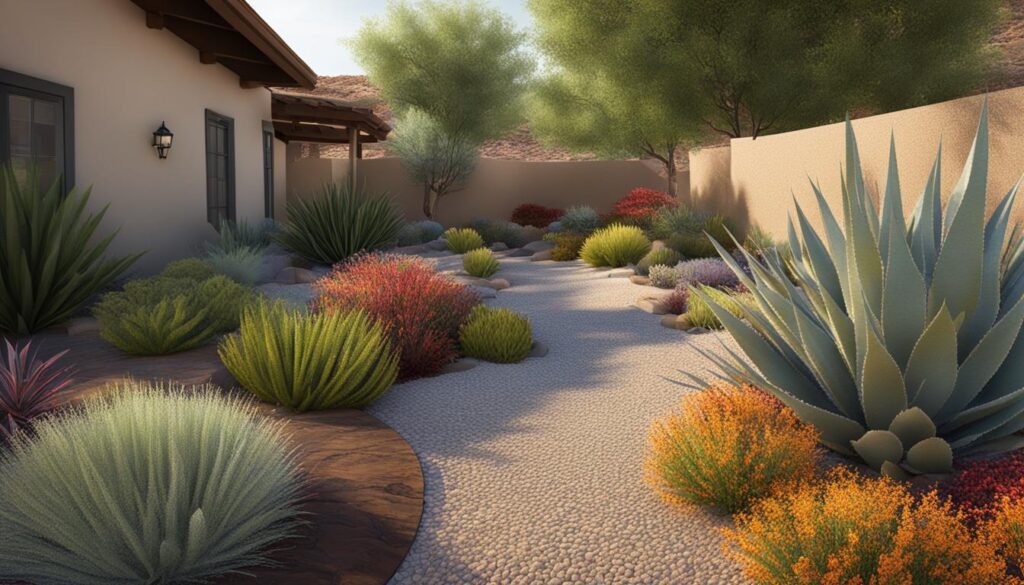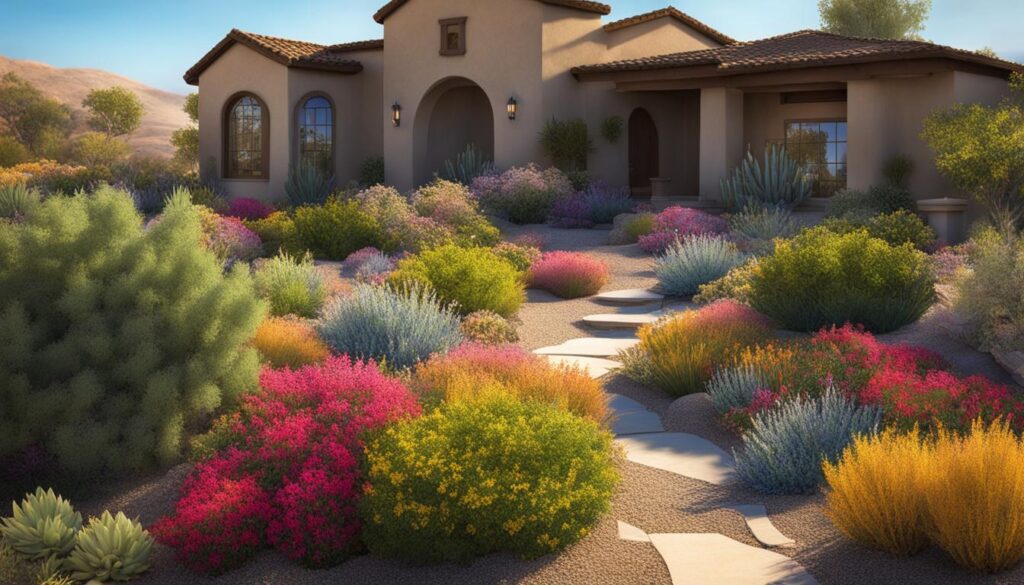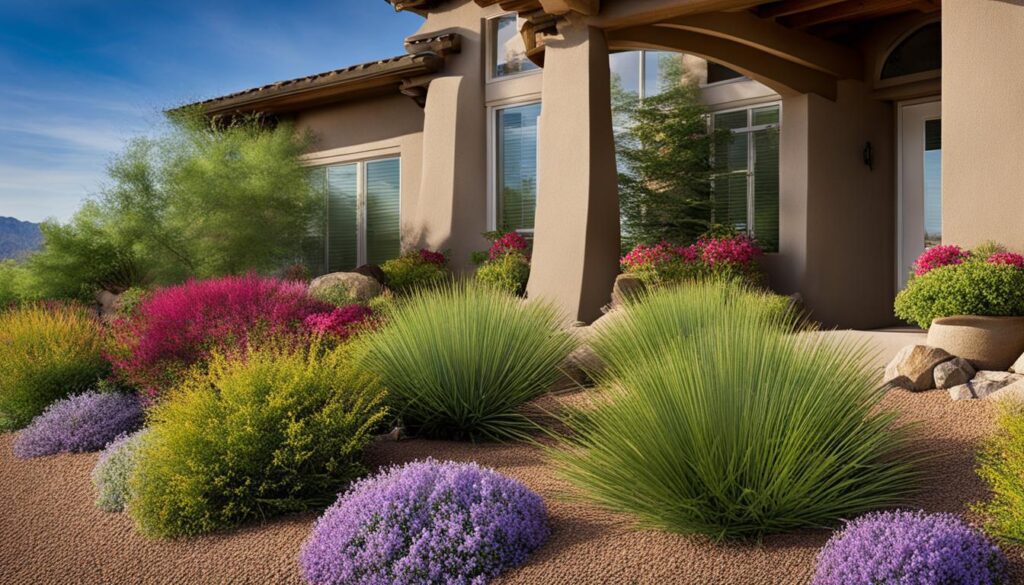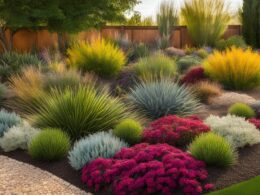Xeriscaping is a low-water gardening technique that can transform dry landscapes into beautiful, thriving gardens. By incorporating heat-tolerant shrubs into your xeriscaped yard, you can create a sustainable and visually appealing outdoor space. This article will explore a variety of heat-tolerant shrubs that are perfect for xeriscaping, providing you with a range of options to choose from.
- Heat-tolerant shrubs are ideal for xeriscaping and can thrive in hot climates with minimal watering.
- Xeriscaping is a low-water gardening technique that focuses on water conservation and reducing the need for irrigation.
- By using heat-tolerant shrubs in xeriscaping, you can add visual interest, color, and texture to your yard.
- Ground cover and low-lying heat-tolerant shrubs provide excellent coverage and require minimal maintenance.
- Drought-tolerant flowering shrubs can bring vibrant blooms to your xeriscaped yard with minimal watering.
What is Xeriscaping and Why is it Important?
Xeriscaping is a low-water gardening technique that has gained popularity in recent years. It involves designing and maintaining landscapes in a way that reduces water usage, making it an environmentally-friendly choice for homeowners. By incorporating heat-tolerant shrubs into your xeriscaped yard, you can create a sustainable and visually appealing outdoor space.
Reducing water bills is one of the main benefits of xeriscaping. Traditional landscaping often requires regular watering to keep plants healthy, which can lead to high water bills, especially in dry climates. With xeriscaping, the focus is on using plants that are well-adapted to drought conditions and require minimal watering once established. This not only reduces water usage but also saves you money in the long run.
Another important aspect of xeriscaping is the conservation of water resources. By using low-water gardening techniques, you contribute to the preservation of water sources, which is especially crucial in areas prone to drought. Xeriscaping can help alleviate the strain on local water supplies and promote a more sustainable approach to landscaping.
“Xeriscaping is a landscaping technique that focuses on water conservation and reducing the need for irrigation.”
Furthermore, xeriscaping offers additional benefits beyond water conservation. By selecting the right plants, such as heat-tolerant shrubs, you can create a visually stunning landscape that thrives in hot climates. These shrubs not only add color and texture to your yard but also provide habitat and food for local wildlife, making your xeriscaped yard a more ecologically friendly space.
Key Points:
- Xeriscaping is a low-water gardening technique that reduces water usage and promotes sustainability.
- By incorporating heat-tolerant shrubs into your xeriscaped yard, you can create an aesthetically pleasing outdoor space that thrives in hot climates.
- Reducing water bills and conserving water resources are important benefits of xeriscaping.
- Xeriscaping also provides habitat and food for local wildlife, making it an environmentally friendly landscaping choice.
| Benefits of Xeriscaping | Keywords |
|---|---|
| Reduces water bills | low-water gardening technique, reduce water bills |
| Conserves water resources | low-water gardening technique, reduce water bills |
| Creates visually appealing landscapes | Xeriscaping, heat-tolerant shrubs |
| Provides habitat for wildlife | Xeriscaping, heat-tolerant shrubs |
Benefits of Heat-Tolerant Shrubs in Xeriscaping
Incorporating heat-tolerant shrubs into your xeriscaped yard offers various benefits. These shrubs are well-suited to hot climates and require minimal watering, making them perfect for xeriscaping. Heat-tolerant shrubs can add visual interest, color, and texture to your yard while thriving in low-water conditions. They also provide habitat and food for local wildlife, making your xeriscaped yard a more ecologically friendly space.
One of the key benefits of heat-tolerant shrubs in xeriscaping is their ability to add visual interest and enhance the overall aesthetic of your yard. These shrubs come in a variety of shapes, sizes, and colors, allowing you to create a diverse and visually appealing landscape. Whether you prefer vibrant flowering shrubs or evergreen varieties, there are heat-tolerant options that will suit your design preferences.
In addition to their aesthetic appeal, heat-tolerant shrubs are highly resilient in hot and dry conditions. They have adapted to survive in low-water environments, meaning they require minimal irrigation once established. This not only saves you time and effort but also reduces water consumption, making xeriscaping an environmentally friendly choice.
Furthermore, heat-tolerant shrubs play a vital role in supporting local wildlife. By providing a source of food and habitat, they attract birds, butterflies, and other beneficial insects to your yard. This creates a harmonious ecosystem and contributes to the overall biodiversity of your xeriscaped space.
| Benefits of Heat-Tolerant Shrubs in Xeriscaping |
|---|
| Enhance visual interest and aesthetics |
| Thrives in low-water conditions |
| Reduces water consumption |
| Supports local wildlife and biodiversity |
Ground Cover and Low-Lying Heat-Tolerant Shrubs for Xeriscaping
If you are looking to add lushness and coverage to your xeriscaped yard, ground cover and low-lying heat-tolerant shrubs are the perfect solution. These plants stay close to the ground, creating a beautiful carpet of foliage while requiring minimal maintenance and water. Here are some examples of ground cover and low-lying heat-tolerant shrubs that will thrive in hot climates:
| Plant | Scientific Name | Description |
|---|---|---|
| Sedum rubrotinctum | Sedum rubrotinctum | A succulent with vibrant green leaves that turn red in full sun. The small, jellybean-like leaves spread out, creating a dense ground cover. |
| Pachysandra procumbens | Pachysandra procumbens | An evergreen ground cover with glossy, serrated leaves. It produces small, white flowers in spring and provides excellent coverage in shady areas. |
| Ophiopogon japonicus | Ophiopogon japonicus | A grass-like plant with dark green, arching foliage. It forms dense clumps and produces small spikes of purple or white flowers in summer. |
These ground cover and low-lying heat-tolerant shrubs not only add visual interest and texture to your xeriscaped yard, but they also help prevent soil erosion and suppress weed growth. They are excellent choices for filling in gaps between larger shrubs or for covering large areas in your yard.
Remember to consider the specific growing requirements of each plant, such as sunlight exposure and soil conditions, when incorporating ground cover and low-lying shrubs into your xeriscaping design. By carefully selecting and strategically placing these plants, you can create a beautiful and sustainable landscape that thrives in hot climates.
Drought-Tolerant Flowering Shrubs for Xeriscaping
When it comes to xeriscaping, incorporating drought-tolerant flowering shrubs can add a splash of color and visual interest to your yard while conserving water. These shrubs are well-adapted to hot climates and require minimal watering, making them ideal for xeriscaped yards. Here are some examples of drought-tolerant flowering shrubs that will thrive in low-water conditions:
- Erigeron karvinskianus: Also known as Santa Barbara daisy, this shrub produces masses of small white or pink flowers. It is a hardy plant that can tolerate drought and offers a delicate and charming appeal to any xeriscaped yard.
- Euphorbia myrsinites: Commonly known as myrtle spurge, this shrub features blue-green foliage and clusters of bright yellow flowers. It is a low-growing and drought-tolerant plant that adds texture and color to a xeriscaped garden.
- Callirhoe involucrata: Also referred to as winecups, this shrub displays vibrant magenta or purple flowers that bloom throughout the summer. It is a hardy plant that thrives in dry conditions and provides a pop of eye-catching color to your xeriscaped yard.
By incorporating these drought-tolerant flowering shrubs into your xeriscaping design, you can enjoy a beautiful and water-efficient yard that blooms with life even in hot climates.
Evergreen Heat-Tolerant Shrubs for Xeriscaping
When it comes to xeriscaping, choosing evergreen heat-tolerant shrubs can provide year-round beauty and structural appeal to your outdoor space. These shrubs maintain their green foliage even in hot climates, making them an ideal choice for xeriscaping. Let’s explore some popular evergreen heat-tolerant shrubs that will thrive in low-water conditions.
1. Juniperus conferta
This spreading juniper variety is known for its dense, ground-hugging growth habit and attractive blue-green foliage. Juniperus conferta requires minimal water and is highly tolerant of heat and drought. Its low maintenance nature and ability to provide ground cover make it a versatile choice for xeriscaped yards.
2. Aloe aristata
Aloe aristata, also known as torch plant or lace aloe, is a stunning succulent shrub with thick, spiky leaves arranged in a rosette pattern. This evergreen shrub produces vibrant orange-red flowers during the summer, adding a pop of color to your xeriscaped yard. Aloe aristata thrives in full sun and requires minimal watering, making it an excellent choice for hot and dry climates.
3. Rohdea japonica
Rohdea japonica, commonly known as sacred lily, is a hardy evergreen shrub that can tolerate a wide range of growing conditions. Its dark green, leathery leaves provide a lush backdrop for your xeriscaped yard, while its small, inconspicuous flowers add a subtle touch of beauty. Rohdea japonica prefers partial shade and requires minimal watering once established.
These evergreen heat-tolerant shrubs can be wonderful additions to your xeriscaped yard, bringing year-round beauty and durability to your outdoor space. With their ability to thrive in hot and dry conditions while requiring minimal water, they are the perfect choice for creating a sustainable and visually appealing xeriscaped landscape.
Ornamental Heat-Tolerant Shrubs for Xeriscaping
When it comes to xeriscaping, incorporating ornamental heat-tolerant shrubs can bring both beauty and visual interest to your yard. These shrubs not only thrive in hot climates but also offer unique shapes, colors, and textures that make them stand out. Let’s explore some popular options for ornamental heat-tolerant shrubs that can enhance your xeriscaped yard.
Salvia sonomensis
Salvia sonomensis, also known as Creeping Sage or Creeping Salvia, is a stunning ornamental shrub that thrives in hot, dry conditions. Its trailing growth habit and vibrant purple flowers create a visually captivating display. This shrub is low-maintenance and can be a great ground cover option for your xeriscaped yard.
Salvia chamaedryoides
Salvia chamaedryoides, commonly known as Germander Sage or Blue Oak Sage, is another attractive ornamental shrub for xeriscaping. Its small, gray-green leaves and intense blue flowers add a pop of color to your yard. This drought-tolerant shrub is also a favorite among pollinators, attracting butterflies and bees.
Sedum kamtschaticum
Sedum kamtschaticum, also called Orange Stonecrop or Russian Stonecrop, is a low-growing succulent shrub that forms colorful, star-shaped flowers in shades of orange and yellow. This resilient plant can withstand hot temperatures and requires minimal watering. It can be an excellent choice for rock gardens or as a border plant in your xeriscaped yard.
| Shrub | Common Name | Main Features |
|---|---|---|
 |
Salvia sonomensis | Trailing growth habit, vibrant purple flowers |
| Salvia chamaedryoides | Small gray-green leaves, intense blue flowers | |
| Sedum kamtschaticum | Low-growing succulent, orange and yellow star-shaped flowers |
These are just a few examples of ornamental heat-tolerant shrubs that can elevate the beauty of your xeriscaped yard. By incorporating these visually appealing shrubs into your landscaping, you can create a sustainable and stunning outdoor space that thrives in hot climates.
Native Heat-Tolerant Shrubs for Xeriscaping
Using native heat-tolerant shrubs in xeriscaping is an excellent way to create a sustainable and ecologically friendly yard. Native plants are well-adapted to the local climate and require minimal maintenance and water. By incorporating native heat-tolerant shrubs into your xeriscaped yard, you can not only reduce your water usage but also support the local ecosystem and wildlife.
Here are some examples of native heat-tolerant shrubs that thrive in xeriscaping:
- Salvia guaranitica: With its vibrant blue flowers, this shrub adds a pop of color to your xeriscaped yard while attracting pollinators like bees and butterflies.
- Fallugia paradoxa: Also known as Apache plume, this shrub features delicate white flowers and silvery seed heads that add visual interest to your yard.
- Opuntia basilaris: Commonly known as beavertail cactus, this low-growing shrub has flattened pads and beautiful pink flowers, making it a unique addition to your xeriscaped garden.
These native heat-tolerant shrubs not only provide visual appeal but also offer habitat and food for local wildlife. Their ability to thrive in hot climates with minimal water make them a sustainable choice for xeriscaping. Incorporating these shrubs into your yard will not only create a beautiful outdoor space but also contribute to the conservation of your local environment.
Tips for Xeriscaping with Heat-Tolerant Shrubs
When xeriscaping with heat-tolerant shrubs, there are several tips to keep in mind to ensure the success of your landscape. By following these guidelines, you can create a beautiful, sustainable outdoor space that thrives in hot climates with minimal water usage.
1. Select Plants Suited to Hot Climates
Choosing heat-tolerant shrubs that are well-adapted to your local climate is crucial for xeriscaping success. Look for plants that have a reputation for withstanding high temperatures and drought conditions. Native species often thrive in hot climates and require less maintenance. Research the specific needs of each shrub to ensure it can thrive in your area.
2. Group Plants with Similar Water Needs
Efficient water usage is key in xeriscaping. Grouping plants with similar water needs together allows for more targeted watering, reducing waste and ensuring each shrub receives the appropriate amount of water. Consider the water requirements of each plant when planning your landscape, and create zones with different watering schedules.
3. Use Targeted Irrigation Systems
Utilizing efficient irrigation systems can greatly reduce water waste in a xeriscaped yard. Drip irrigation, for example, delivers water directly to the root zone of the plants, minimizing evaporation and runoff. Install a system that allows for precise control over watering, such as programmable timers or sensors that adjust irrigation based on soil moisture levels.
By implementing these tips, you can create a xeriscaped yard that not only conserves water but also showcases the beauty of heat-tolerant shrubs. Remember to regularly maintain and prune your shrubs to ensure their health and vitality in low-water conditions.
Maintenance of Heat-Tolerant Shrubs in Xeriscaping
To ensure the health and vitality of your heat-tolerant shrubs in xeriscaping, proper maintenance is key. By following a few simple guidelines, you can keep your shrubs thriving in low-water conditions and enjoy a beautiful, sustainable yard.
Watering
While heat-tolerant shrubs are designed to withstand dry climates, they still require some watering, especially during their establishment period. Once established, these shrubs typically only need watering during prolonged periods of drought. However, it’s important to monitor soil moisture levels and adjust watering accordingly.
When watering, it’s best to provide deep, infrequent soakings rather than frequent shallow waterings. This encourages the shrub’s roots to grow deeper and helps them become more drought-resistant. Consider using drip irrigation or a soaker hose to deliver water directly to the shrubs’ root zones, minimizing water waste.
Pruning
Regular pruning is essential for the maintenance of heat-tolerant shrubs. Pruning helps shape the shrubs, removes dead or diseased branches, and promotes healthy growth. It’s best to prune heat-tolerant shrubs during their dormant season, typically in late winter or early spring.
When pruning, make clean cuts just above a bud or lateral branch. Avoid removing more than one-third of the shrub’s total growth in a single pruning session. This helps prevent stress and encourages the shrub to maintain its natural shape and form.
Pest and Disease Control
Keep an eye out for common pests and diseases that may affect heat-tolerant shrubs in xeriscaping. Common pests include aphids, spider mites, and whiteflies. Regularly inspect your shrubs for signs of infestation, such as distorted leaves or sticky residue. If necessary, treat the affected shrubs with organic insecticides or employ natural pest control methods like introducing beneficial insects.
Additionally, monitor your shrubs for signs of diseases like powdery mildew or leaf spot. If you notice any disease symptoms, remove and dispose of affected branches or leaves to prevent the spread of the disease. Proper spacing and good air circulation also help minimize the risk of fungal diseases.
By following these maintenance tips, you can ensure the long-term success of your heat-tolerant shrubs in xeriscaping. Remember to adapt your maintenance routine based on the specific needs of each shrub and the local climate conditions. With proper care, your shrubs will continue to add beauty, color, and sustainability to your xeriscaped yard.
Conclusion
Heat-tolerant shrubs are an excellent choice for xeriscaping, allowing you to create a sustainable and visually appealing yard that thrives in hot climates with minimal watering. By incorporating a variety of these shrubs, you can transform your outdoor space into a diverse and vibrant xeriscaped oasis.
Remember to carefully consider the specific needs and requirements of each heat-tolerant shrub when planning and maintaining your xeriscaped yard. Group plants with similar water needs together and use targeted irrigation systems to minimize water waste. With proper care and attention, your heat-tolerant shrubs will flourish and provide both beauty and sustainability to your outdoor space.
Whether you choose low-lying ground cover shrubs, drought-tolerant flowering shrubs, evergreen varieties, or ornamental options, these heat-tolerant shrubs will add color, texture, and visual interest to your xeriscaped yard. Not only will they beautify your space, but they will also support local ecosystems and provide habitat for wildlife.
So, get ready to transform your yard into a stunning xeriscaped paradise with heat-tolerant shrubs. With their ability to withstand hot climates and their minimal watering needs, these shrubs are the perfect choice for creating a sustainable and visually appealing outdoor space that you can enjoy for years to come.
FAQ
What is xeriscaping?
Xeriscaping is a landscaping technique that focuses on water conservation and reducing the need for irrigation by using plants that are well-adapted to dry conditions and require minimal watering.
Why is xeriscaping important?
Xeriscaping is important because it can save water, reduce water bills, and create a sustainable and visually appealing yard.
What are the benefits of using heat-tolerant shrubs in xeriscaping?
Heat-tolerant shrubs are well-suited to hot climates, require minimal watering, add visual interest, provide habitat for wildlife, and make your yard more ecologically friendly.
What are some examples of ground cover and low-lying heat-tolerant shrubs for xeriscaping?
Examples include Sedum rubrotinctum, Pachysandra procumbens, and Ophiopogon japonicus.
What are some examples of drought-tolerant flowering shrubs for xeriscaping?
Examples include Erigeron karvinskianus, Euphorbia myrsinites, and Callirhoe involucrata.
What are some examples of evergreen heat-tolerant shrubs for xeriscaping?
Examples include Juniperus conferta, Aloe aristata, and Rohdea japonica.
What are some examples of ornamental heat-tolerant shrubs for xeriscaping?
Examples include Salvia sonomensis, Salvia chamaedryoides, and Sedum kamtschaticum.
What are some examples of native heat-tolerant shrubs for xeriscaping?
Examples include Salvia guaranitica, Fallugia paradoxa, and Opuntia basilaris.
What are some tips for xeriscaping with heat-tolerant shrubs?
Tips include selecting plants well-adapted to hot climates, grouping plants with similar water needs together, and using targeted irrigation systems.
How should I maintain heat-tolerant shrubs in xeriscaping?
Regular watering, pruning, monitoring for pests and diseases, mulching, and occasional supplemental watering during extreme heat are important for maintenance.
What are the key takeaways about xeriscaping with heat-tolerant shrubs?
Xeriscaping with heat-tolerant shrubs can transform your yard into a sustainable and visually appealing space with minimal watering.













